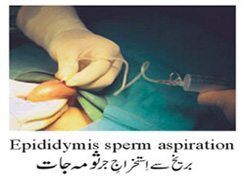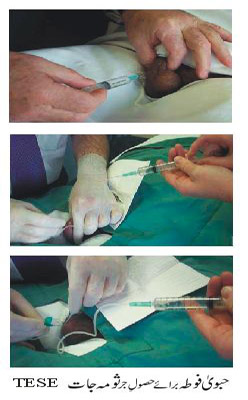|
|
|
Percutaneous Epididymal Sperm Aspiration (PESA). A small needle is placed into the epididymis using local anesthesia and sperm are withdrawn. The epididymis normally serves as a reservoir for sperm. PESA procedure has excellent potential for Men who have had a vasectomy and do not wish to undergo reversal, or who have had a failed attempted reversal. Men with congenital absence of the vas deferens or infective occlusion of the epididymis and those with ejaculatory dysfunction due to multiple sclerosis or diabetes. |
 |
Testicular Sperm Extraction (TESE) is useful for men who have non-obstructive azoospermia caused from maturation arrest disorders and in whom sperm could not be obtained through the PESA procedure. Using TESE, sperm are obtained by biopsy of the testicle. It is possible to obtain sperm using TESE even when there are none seen in the ejaculate.
These techniques are relatively simple, the equipment required is minimal and the procedures are much less invasive than the previous microsurgical approaches. The man returns to work either the same day or the following day without significant risk of complications. The various steps in ICSI procedure are:
|
 |
-
After 24 hours fertilization cleavage, and number and size of blastomeres is seen.
-
After another 24 hours (48 hours after sperm injection) if needed assisted hatching is done.
|
In ICSI All the steps are similar to conventional IVF-ET except that there is microinjection of sperms into the ovum instead of simple placement of eggs and sperms together. With the advent of ICSI, IVF is offered to any couple desiring assistance to be parents with greater confidence. Fertilization rates > 90 % are achieved with this technique.
Often the pregnancy rate statistics for ICSI do not appear much different than pregnancy rates of those who do not need ICSI. This is believed to be because patients, who need ICSI, traditionally have more severe causes of infertility. There is no conclusive proof that ICSI for traditional IVF enhances overall pregnancy rates, with the exception of male factor and fertilization failure.
|
|









